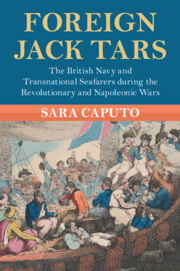 Foreign Jack Tars
Foreign Jack Tars Birthplace and Demographic Profiles
from Part I - The State
Published online by Cambridge University Press: 03 November 2022
Chapter 1 tackles ‘foreigners’ defined as such on the basis of their birthplace, as recorded in naval crew musters. Statistical analysis of a sample of 4,392 seamen who served in extra-European stations shows that the proportion of foreign-born men rose between the beginning and the end of the French Wars, likely reflecting the increased demand for manpower. Nearly half of them came not from British imperial or ex-imperial territories, but from continental Europe. Questioning the meaningfulness of categorisations by birthplace, however, the chapter also deploys them as a working hypothesis. The results show that Irish-born, rather than foreign-born, seamen displayed the most distinctive demographic patterns, being on average the oldest but disproportionately employed as ‘landsmen’ – the least skilled and lowest-paid rating. Being born abroad affected the likelihood of promotion to petty officer, and in some cases to able seaman, but it otherwise mattered little in determining a man’s position aboard. Rating was also independent of cultural capital, crudely measured through estimated group numeracy. Overall, a line sharply drawn between the men born in the British Isles and Ireland and those born abroad is a relatively poor predictor of demographic or employment differences.
To save this book to your Kindle, first ensure no-reply@cambridge.org is added to your Approved Personal Document E-mail List under your Personal Document Settings on the Manage Your Content and Devices page of your Amazon account. Then enter the ‘name’ part of your Kindle email address below. Find out more about saving to your Kindle.
Note you can select to save to either the @free.kindle.com or @kindle.com variations. ‘@free.kindle.com’ emails are free but can only be saved to your device when it is connected to wi-fi. ‘@kindle.com’ emails can be delivered even when you are not connected to wi-fi, but note that service fees apply.
Find out more about the Kindle Personal Document Service.
To save content items to your account, please confirm that you agree to abide by our usage policies. If this is the first time you use this feature, you will be asked to authorise Cambridge Core to connect with your account. Find out more about saving content to Dropbox.
To save content items to your account, please confirm that you agree to abide by our usage policies. If this is the first time you use this feature, you will be asked to authorise Cambridge Core to connect with your account. Find out more about saving content to Google Drive.